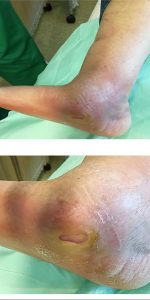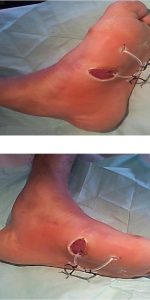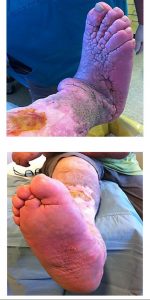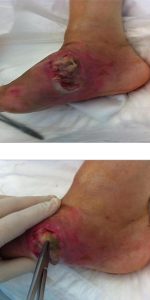Questa tesi di laurea è stata presentata durante il Master sulla gestione delle lesioni cutanee dell’Università La Sapienza di Roma
Autore: Velàsquez Santisteban Antony Brayan – Infermiere di area critica presso OSA – Operatori Sanitari Associati
Nell’ambito del master universitario in Wound Care e grazie all’esperienza maturata nel corso del tirocinio svolto presso l’ospedale Sant’Andrea di Roma sono stato spinto ad approfondire la tematica del piede di Charcot, una condizione clinica complessa ed interessante da indagare.
Mi sono chiesto quanto una giusta diagnosi e di conseguenza una corretta prevenzione potessero salvare i pazienti da questa grave complicanza. Nella fase iniziale, quando la malattia si manifesta con sintomi a volte scambiati per altro, la figura professionale dell’infermiere ―wound specialist‖ può rivelarsi fondamentale e lanciare il primo campanello d’allarme nella giusta direzione.
Casi clinici sul piede di Charcot
Da molti anni i progressi nella cura della malattia diabetica hanno portato ad un allungamento dell’aspettativa di vita dei pazienti. I problemi principali oggi non sono più quelli legati alla sopravvivenza bensì quelli riguardanti le complicanze croniche, sia microangiopatiche (retinopatia, nefropatia, neuropatia) che macroangiopatiche (cardiopatia ischemica, arteriopatia degli arti inferiori). Tra le complicanze del diabete un ruolo sempre più rilevante è assunto dalla cosiddetta neuro – osteoartropatia di Charcot più nota come “piede di Charcot “.
Il presente lavoro nasce da una riflessione sui gravi danni che questa complicanza provoca nei pazienti che ne sono affetti. Durante la mia esperienza di tirocinio ho potuto verificare come il piede di Charcot colpisse maggiormente i soggetti con diabete mellito, ragion per cui, nell’ambito del presente elaborato, mi sono soffermato con particolare attenzione su questa tipologia di pazienti.
Bisogna specificare comunque che questa condizione clinica non riguarda solamente i diabetici ma può insorgere anche in pazienti affetti da gravi malattie neurologiche e motorie.
Il ruolo dell’infermiere wound specialist nei confronti di questa complicanza è orientato soprattutto verso la prevenzione della malattia e verso una forma di educazione del paziente, volta a favorire un comportamento consapevole da parte di quest’ultimo nella cura del piede.
Il presente elaborato, dal titolo ―Ruolo dell’infermiere Wound Specialist nella prevenzione del piede di Charcot‖ si compone di tre capitoli, nel primo viene fatta un’introduzione storica degli studi sulla malattia, si illustrano le probabili cause attualmente riconosciute.
Nel secondo capitolo si descrive il percorso diagnostico-terapeutico del piede di Charcot ritenuto il più moderno e diffusamente accettato nel mondo mentre il terzo rappresenta il fulcro della tesi, poiché si pone come obiettivo quello di sensibilizzare sulla gravità della malattia di Charcot tutti gli operatori sanitari, da quelli che fanno parte del team diabetologico a quelli che lavorano in altri ambiti clinici, sia all’interno dell’ospedale sia a domicilio. A questo scopo ci si sofferma sul ruolo professionale dell’infermiere esperto in wound care il quale può garantire un corretto approccio ai pazienti affetti da questa condizione clinica.
LA TESI INTEGRALE IN FORMATO PDF
La figura professionale dell’ infermiere wound specialist come punto di riferimento per le persone colpite da piede di Charcot
La NOA incide in maniera devastante sulla qualità della vita delle persone che ne sono affette. A partire da questo dato, possiamo dire che la figura professionale dell’infermiere wound specialist riveste un ruolo di primaria importanza nella gestione dei vari aspetti della malattia.
L’infermiere esperto in Wound Care è uno specialista in campo assistenziale che, grazie al suo percorso di studi post-universitari (master di I livello), ha un bagaglio teorico-pratico di conoscenze specialistiche sulle complicanze vasculopatiche e neuropatiche del diabete mellito e nel trattamento delle ferite difficili. Questa figura professionale ha delle competenze avanzate relative alla gestione dei problemi assistenziali di persone con lesioni cutanee e può svolgere la sua attività in ambiti clinici assistenziali, organizzativi e gestionali.
Grazie alle sue competenze specialistiche il wound specialist è in grado di lanciare il primo campanello d’allarme e riconoscere in maniera tempestiva i sintomi, o eventuali fattori di rischio, che possono dar luogo alla comparsa del piede di Charcot. Interviene anche come filtro indirizzando i soggetti verso i centri specialistici per il trattamento del piede diabetico oppure verso ambulatori per il trattamento di ferite difficili, come quello presente all’interno dell’ospedale Sant’Andrea di Roma.
Le competenze del wound specialist non si limitano solo all’assistenza diretta e all’applicazione delle più avanzate tecniche nell’ambito del trattamento, ma riguardano anche la prevenzione dei problemi legati al piede diabetico come per esempio lesioni, deformità, ulcerazione, amputazione. Nell’ambito della prevenzione egli stimola e responsabilizza i pazienti alla cura dei propri piedi ed interviene anche nella gestione della malattia, garantendo un supporto morale e psicologico per tutta la durata del trattamento con l’obiettivo di migliorare la compliance del paziente a non mollare e a continuare a svolgere le sue attività quotidiane in maniera normale. Assiste in maniera diretta il paziente quando la malattia nella sua fase cronica ha creato l’ulcerazione del piede, attraverso le medicazioni con l’obiettivo che una volta guarite le lesioni, il paziente possa iniziare una buona riabilitazione98 .
CONCLUSIONI
A conclusione del presente lavoro e dai casi clinici riscontrati durante il periodo di tirocinio, posso affermare che le persone affette da piede di Charcot purtroppo si rivolgono ad una struttura ospedaliera quando ormai la malattia ha già creato gravi danni.
Le ultime linee guida dell’ International Diabetes Federation 2017, affermano in maniera chiara che il numero di persone che vive con il diabete in tutto il mondo è destinato ad aumentare. Partendo da questo assunto è evidente che la popolazione a rischio di sviluppare le numerose complicanze legate a questa patologia, tra queste quindi anche la NOA, aumenta in maniera esponenziale al punto che ogni paziente affetto da diabete è potenzialmente a rischio.
Ritorna quindi in primo piano il problema della diagnosi precoce e della consapevolezza che tutti gli operatori sanitari, nella loro pratica clinica, dovrebbero avere nel riconoscimento dei primi segnali, a volte molto latenti, della neuro – osteoartropatia di Charcot. L’individuazione precoce consente l’indirizzamento del paziente verso un’assistenza specialistica adeguata che riguarda l’ambito del wound care.
Come emerso da questo elaborato la figura professionale specialistica dell’infermiere esperto in wound care si rivela di grande valore dal punto di vista della prevenzione e della cura totale dei pazienti. La speranza per il futuro prossimo è quella di vedere formalmente riconosciuta, in Italia così come nei paesi anglosassoni, la sua professionalità in ambito sanitario.
BIBLIOGRAFIA ALIKHANI M, ALIKHANI Z, BOYD C, MACLELLAN CM, RAPTIS M, LIU R. ―Advanced glycation end products stimulate osteoblast apoptosis via the MAP kinase and cytosolic apoptotic pathways‖, Bone, 2007; vol 40, pp.345–353. ANICHINI R, POLICARDO L, LOMBARDO F, SALUTINI E, TEDESCHI A, VITI S, FRANCIA P, BROCCO E, MAGGINI M, SEGHIERI G, DE BELLIS A, ― Hospitalization for Charcot neuroarthropathy in diabetes: A population study in Italy ―, Diabetes research and clinical practice, 2017, vol 29, pp. 25 -31 ARMSTROMG DG, STACPOOLE-SHEA S, NGUYEN H, HARKLESS LB. ―Lengthening of the Achilles tendon in diabetic patients who are at high risk for ulceration of the foot‖. J Bone Joint Surg Am, 1999, vol 81, pp. 535-538. ARMSTRONG DG, TODD WF, LAVERY LA, HARKLESS LB, BUSHMAN TR, ―The natural history of acute Charcot’s arthropathy in the diabetic foot specialty clinic‖, Diabet Med, 1997, vol 14, pp.357- 363 BASU S, CHRYSSKOS T, HOUSENI M, et al, ―Potential role of FDG PET in the setting of diabetic neuro-osteoarthropathy: can it differentiate uncomplicated Charcot’s neuroarthropathy from osteomyelitis and softtissue infection?, Nucl Med Commun,2007, vol 27, pp.465–472. BATES, M., PETROVA, N. L., & EDMONSDS, M. E. ―How long does it take to progress from cast to shoes in the management of Charcot osteoarthropathy? ―, Diabetic Foot Study Group of the EASD, 2005 BELLINGERI A., ―Il prontuario per la gestione delle lesioni cutanee‖, Ed Medea, 2017, pp. 119-121 BEM R, JIRKOVSKA A, FEJFAROVA V, SKIVOBA J, JUDE EB, “Intranasal calcitonin in the treatment of acute Charcot neuro-osteoarthropathy‖. Diabetes Care, 2006, vol 29, pp.1313–1392 BERLINER MEDICINISCHE GESELLSCHAFT . Sitzung vom 17 November. Berliner Klinische Wonchenschr 1886 BRAKE J., ―Keeping abreast of the latest diabetes research: Apps, low-carb diets, Charcot neuroarthropathy and non-attendance‖, Journal of Diabetes Nursing, 2016, vol 20, n° 10, p. 370 BRODSKY JW, ―The diabetic foot. In: Coughlin MJ, Mann RA, Saltzman CL, eds. Surgery of the Foot and Ankle‖. 8th ed. St. Louis, MO, 2006, pp.1281-1368 BROSKY T, RECKNOR C, GRANT S, ―The effect of teriparatide [human parathyroid hormone (1–34)] therapy on fracture healing in Charcot neuroarthropathy of lower extremity‖. OsteoporosInt, 2005; vol 16, p.44 BROWN D, WERTSCH JJ, HARRIS GF, KLEIN J, JANISSE D, ―Effect of rocker soles on plantar pressures‖. Arch Phys Med Rehabil, 2004, vol 85, pp.81-86 BUS SA, ULBRECHT JS, CAVANAGH PR, ―Pressure relief and load redistribution by custom-made insoles in diabetic patients with neuropathy and foot deformity‖. Clin Biomech, 2004, vol 19, pp.629-638 CAPUTO GM, ULBTRECH J, CAVANAGH PR, JULIANO P, ―The Charcot foot in diabetes: six key points‖. Am Fam Physician, 1998, vol 57, pp.2705-2710. CHANTELAU E, ― The perils of procrastination: effects of early vs delayend detection and treatment of incipient Charcot fracture‖, Diabet Med, 2005, vol 22, pp.1707-1712 CHARCOT JM, & FÈRÈ C, “Affections osseuses et articulaires du pied chez les tabétiques (Pied tabétique)‖. Archives de Neurologie, 1883, vol 6, pp.305-319. CHARCOT JM, ―Surquelques arthropathies qui paraissent dependre d’une lesion du cerveau ou de la moelle epiniere, Arch Physiol Norm Patho‖, 1868: vol 1, pp. 161-178 COFIELD RH, MORRISON MJ, BEABOUT JW. ―Diabetic neuroarthropathy in the foot: patient characteristics and patterns of radiographic change‖, . Foot Ankle, 1983, vol 4, pp.15-22 CONCANNON M., SHARPE A.‖ The importance of screening for Charcot neuroarthropathy‖, Practice nursing, 2012, vol 23, n°8, pp.401-405 CRERAND S, DOLAN M, LAING P, BIRD M, SMITH ML, KLENERMAN L. ―Diagnosis of osteomyelitis in neuropathic foot ulcers‖, J Bone Joint Surg Br, 1996, vol 78, pp.51–55 CUNDY TF, EDMONDS ME, WATKINS PJ, ―Osteopenia and metatarsal fractures in diabetic neuropathy‖, Diabet Med, 1985; vol 2, pp. 461–464 DAHMEN R, HASPELS R, KOOMEN B, HOEKSMA AF, ―Therapeutic footwear for the neuropathic foot: an algorithm‖. Diabetes Care,2001,vol 24, pp.705-709 DALLA PAOLA L, VOLPE A, VAROTTO D, POSTORRINO A, BROCCO E, SENESI A, MERICO M, DA ROSS R, ASSALONI R, ―Use of a retrograde nail for ankle arthrodesis in Charcot neuroarthropathy: a limb salvage procedure‖. Foot Ankl Int, 2007, vol 28, pp. 967–970 DE CORRADO G, REPETTI E, LATINA A, VIGLIONE P, GRASSI F, LOVULLO M, CORTESE M, FERNICOLA F, GAMBAUDO R., MOLINA E., ROSSO F., GENTILE L., ―Un approccio di cura multidisciplinare al piede diabetico può ridurre l’incidenza di ulcere e amputazioni: risultati dello studio di Asti a 12 anni‖, G It Diabetol Metab, 2013, vol 33, pp.90-97 DE SOUZA LJ, ―Charcot arthropathy and immobilization in a weighbearing total contact cast‖, J Bone Joint Surg Am, 2008, vol 90, pp.754–759 EDMONDS ME, ―The neuropathic foot in diabetes. Part I:Blood flo‖, Diabetic Med, 1986, vol 3, pp.111-115 EICHENHOLTZ SN, ― Charcot joints‖, Springfield,Ill, Thomas,1966 FABRIN J, LARSEN K, HOLSTEIN PE, ―Long-term follow-up in diabetic Charcot feet with spontaneous onset‖. Diabetes Care, 2000, vol 6, pp.796-800 FAUZI AA, CHUNG TY, LATIF LA, ―Risk factors of diabetic foot charcot arthropathy: a case-control study at a malaysian tertiary care centre‖, Singapore Med , 2016, vol 57, n° 4, pp. 198-203 FRYKBERG RG, BELCZYK R, ―Epidemiology of the charcot foot‖, Clin Podiatr Med Surg , 2008, vol 25, pp.17-28 FRYKBERG RG, SANDERS LJ, ― The Charcot foot, In The High Risk Foot in Diabetes Mellitus‖, edited by R Frykberg, Churchill Livingstone, New York, 1991, pp 325– 335 GALEONE FRANCESCO, “Diabete e patologie osteoarticolari”, Ed living, 2011; pp. 51-61 GAME FL, CATLOW R, JONES GR, EDMONDS ME, JUDE EB, RAYMAN G, JEFFCOATE WJ, “Audit of acute Charcot's disease in the UK: the CDUK study”. Diabetologia, 2012, vol 55, pp 32- 35 GAZIS A, POUND N, MACFARLANE R, TREECE K, GAME F, JEFFCOATE W, ―Mortality in patients with diabetic neuropathic osteoarthropathy(charcot foot)‖, Diabet Med 2004, vol 21, pp. 1243-1246 GEORG O, THOMAS B, Berli M, ― Recurrence of Acute Charcot Neuropathic Osteoarthropathy After Conservative Treatment‖. Foot&Ankle International January 10, 2013 GOLD RH, TONG DJ, CRIM JR, SEEGER LL, ―Imaging the diabetic foot ―. Skeletal Radiol. 1995, vol 24, pp.563–571 GRANT WP, SULLIVAN R, SONENSHINE DE, ADAM M, SLUSSER JH, CARSON KA, VINIK AI, ―Electron microscopic investigation of the effects of diabetes mellitus on the Achilles tendon‖., J Foot Ankle Surg, 1997, vol 36, pp.272–278 GULDEMOND NA, LEFFERS P, SCHAPER NC et Al, ―The effects of insole configuration on forefoot plantar pressure and walking convenience in diabetic patients with neuropathic feet‖. Clin Biomech, 2007, vol 22, pp.81-87 HARRELSON JM, ―The diabetic foot: Charcot arthropathy‖, Instr Course Lect, 1993, vol 42, pp. 141-146. HASTINGS MK, MUELLER MJ, SINACORE DR, SALSICH GB, ENGSBERG JR, JOHNSON JE,‖ Effects of a tendo-Achilles lengthening procedure on muscle function and gait characteristics in a patient with diabetes mellitus‖. J Orthop Sports PhysTher, 2000, vol 30, pp.85–90 HERBST SA, JONES KB, SALTZMAN CL, ― Pattern of diabetic neuropathic arthropathy associated with the peripheral bone mineral density‖, J Bone Joint Surg Br, 2004;vol 3,pp.378-383 HOTOLEANOU C, FODOR D, SUCIU O, ―Correlations between clinical probability and Doppler ultrasound results in the assessment of deep venous thrombosis‖, Med Ultrason, 2010, vol 12, pp.17-21 JACQUELINE B, RN, MSN, NP-C, ― Identifying the Charcot foot‖, Advances in skin & Wound care, 2006, vol 19, n°4, pp. 189-190 JORDAN WR, ―Neuritic manifestations in diabetes mellitus‖, Arch Intern Med, 1936, vol 57, pp 307-366 LAURINAVICIENE R, KiIRKETERP-MOELLER K, HOLSTEIN PE. ―Exostectomy for chronic midfoot plantar ulcer in Charcot deformity‖. J Wound Care, 2008, vol 17, pp.57–58 LEDERMANN HP, MORRISON WB, ―Differential diagnosis of pedal osteomyelitis and diabetic neuroarthropathy: MR imaging. Semin Musculoskelet‖ Radiol, 2005,vol 9, pp.272-283 LEE C, ROGERS, FRYKBERG, ROBERT G, DAVID G, ARMSTRONG, ANDREW J.M, EDMONDS HARTEMANN A, GAME F, JEFFCOATE W, JIRKOVSKA A, JUDE E, MORBACH, MORRISON, PINZUR, PITOCCO D, SANDERS L, WUKICH DK, UCCIOLI L, ― The Charcot foot in Diabetes‖ , Diabetes Care, 2011, vol 34, pp. 2123-2129 MACCORMAC W, KLOCKMANN JW, ―Transactions of the international medical congress : seventh session held in London‖, 1881, vol 1, pp. 128-129 MATRICALI GA, BAMMENS B, KUYPERS D, FLOUR M, MATHIEU C, ―High rate of charcot foot attacks early after simultaneous pancreas-kidney trnasplantation‖, Transplantation 2007, vol 83, pp. 245-246 MCGILL M, MOLYNEAUX L, BOLTON T, IOANNOU K, UREN R, YUE DK. ―Response of Charcot’s arthropathy to contact casting: assessment by quantitative techniques‖. Diabetologia, 2000, vol 43, pp.481–484 MITCHELL J.K. ―On a new practice in acute and chronic rheumatism‖, Am J Med Sci, 1831; pp. 55-64 MOHAMMED AM, MAHMOUD AA, JIHAD AA, NIDAL Y, ― Clinical factors associated with Charcot foot‖, The Diabetic Foot Journal, 2011, vol 14, n°3, pp 124-129 MYERSON MS, HENDERSON MR, SAXBY T, SHORT KW, ― Management of midfoot diabetic neuroarthropathy‖, Foot Ankle Int, 1994, vol 15, pp.233–241 PALESTRO CJ, MEHTA HH, PATEL M, FREMANN SJ, HARRINGTON WN, TOMAS MB, MARWIN SE, ― Marrow versus infection in the Charcot joint: indium111 leukocyte and technetium-99m sulfur colloid scintigraphy‖, J Nucl Med, 1998, vol 39, pp.346–350 PANUCCIO V, ENIA G, TRIPEPI R, ALIOTTA R, MALLAMACI F, TRIPEPI G, ZOCCALI C, ―Pro-inflammatory cytokines and bone fractures in CKD patients.An exploratory single centre study ―, BMC Nephrol, 2012, vol 13, p. 134 PAPANAS N, MALTEZOS E, ―The diabetic foot: established and emerging treatments‖. ActaClin Belg, 2007, vol 62, pp.230–238 PETROVA NL, EDMONDAS ME, ―Medical management of Charcot arthropathy‖, Diabetes, Obesity and Metabolism, 2013, vol 12, pp. 193-197 PETROVA NL, FOSTER AV, EDMONDS ME, ― Difference in presentation of Charcot osteoarthropathy in type 1 compared with type 2 diabetes‖,. Diabetes Care. 2004 , vol5, pp.1235- 1236. PETROVA NL, FOSTER AV, EDMONDS ME, ―Calcaneal bone mineral density in patients with Charcot neuropathic osteoarthropathy: differences between Type 1 and Type 2 diabetes‖, Diabet Med, 2005; vol22, pp. 756–761 PICKEWLL KM, VAN KROONENBURGH MJ, WEIJERS RE, VAN HIRTUM PV, HUIJBERTS MS, SCHAPER NC, ― F-18 FDG PET/CT scanning in Charcot disease: a brief report‖. Clin Nucl Med, 2011, vol 38, pp.8-10 PITOCCO D, RUOTOLO V, CAPUTO S et Al. ―Six-month treatment with alendronate in acute Charcot neuroarthropathy: a randomized controlled trial‖. Diabetes Care, 2005, vol 28, pp.1214–1215 PITOCCO D, ZELANO G, GIUFFRÈ G, DI STASIO E, ZACCARDI F, MARTINI F, MUSELLA T, SCAVONE G, GALLI M, CAPUTO S, MANCINI L, GHIRLANDA G, “Association between osteoprotegerin G1181C and T245G polymorphyns and diabetic charcot neuroarthropathy: a casa control study‖, Diabetes care, 2009, vol 32, pp. 1694- 1697 QUILLEN DM, ―Crystal arthropathies: recognizing and treating ―the gouch.‖‖ Prim Care, 2010, vol 37, pp.703-711 RAJBHANDARI SM, JENKIS RC, DAVIES C, TESFAYE S. ―Charcot neuroarthropathy in diabetes mellitus‖, Diabetologia 2002, vol 45, pp.1085-1096 RICHARD JL, ALMASTRI M, SCHUDINER S, ―Treatment of acute Charcot foot with bisphosphonates: a systemic review of the literature.‖ Diabetologia ,2012, vol 55, pp. 1258–1264 ROGERS LC, FRYKBERG RG, ARMSTRONG DG, BOULTON AJ, EDMONDS M, VAN GH, HARTEMANN A, GAME F, JEFFCOATE W, JIRKOVSKA A, JUDE E, MORBACH S, MORRISON WB, PINSUR M, PITOCCO D, SANDERS L, WUCKICH DK, UCCIOLI L, ―The Charcot foot in diabetes‖, Diabetes Care, 2011, vol 34,pp. 2123-2129. RUTGER S, WENDY D, MUDGE E, HARDING K, ―Persistent plantar ulceration associated with midfoot charcot deformity‖, Wounds UK, 2013, vol 9, n° 4, pp.72-78 SALTZMAN CL, HAGY ML, ZIMMERMANN B, ESTIN M, COOPER R, ―How effective is intensive nonoperative initial treatment of patients with diabetes and Charcot arthropathy of the feet?‖. Clin Orthop Relat Res, 2005, vol 435, pp.185-190 SANDERS LJ, FRYKBERG RG, ―Diabetic neuropathic osteoarthropathy: Charcot foot. In The High Risk Foot in Diabetes Mellitus‖, Eds. New York, Churchill Livingstone, 1991, pp. 297–338 SCAVONE G, GALLI M, PITOCCO D,CAPUTO S,MUSELLA T,ZACCARDI F, COSTANTINI F, GHIRLANDA G, ― Piede di Charcot: una complicanza del diabete ancora poco conosciuta‖, G It Diabetol Metab, 2012, vol 32, pp. 126-133 SCHON LC, MARKS RM, ―The management of neuroarthropathic fracturedislocations in the diabetic patient‖, Orthop Clin North Am. 1995, vol 26, pp.375-392. SEGALL GM, NINO- MURCIA M, JACOBS T, CHANG K, ― The roles of bone scan and radiography in the diagnostic evaluation of suspected pedal osteomyelitis‖. Clin Nucl Med, 1989, vol 14, pp.255–260 SELBY PL, YOUNG MJ, BOULTON AJHM. ― Bisphosphonates: a new treatment for diabetic Charcot neuroarthropathy?‖, Diabet Med, 1994, vol 11, pp.28-31 SELLA EJ, BARRETTE C, ― Staging of Charcot neuroarthropathy along the medial column of the foot in the diabetic patient‖, J Foot Ankle Surg, 1999, vol 38, pp.34-40 SMITH C, KUMAR S, CAUSBY R ― The effectiveness of non-surgical interventions in the treatment of Charcot foot‖. Int J Evid Based Healthc, 2007, vol 5, pp.437–449 SOHN MW, LEE TA, STUCK RM, FRYKBERG RG, BUDIMAN-MAK, ― Mortality risk of charcot arthropathy compared with that of diabetic foot ulcer and diabetes alone‖, Diabetes care, 2009, vol 32, n°5, pp.816-821 SOHN MW, STUCK RM, PINZUR M, LEE TA, MAK EB, ―Lower-extremity amputation risk after charcot arthropathy and diabetic foot ulcer‖, Diabetes care, 2010, vol 33, n°1, pp. 98-100 SRIVASTAVA S, YOUNIS N, KURDY N, ― Investigating quality of life in people with Charcot neuroarthropathy‖, The diabetic foot journal, 2016, vol 19, n°2, pp.70-74 STEFANSKY SA, ROSEMBLUM BI, ―The Charcot foot: a clinical challenge‖ Int J Low Extrem Wounds, 2005, vol 4, pp.183–187 STUCK RM, SOHN MW, BUDIMAN-MAK E, LEE TA, WEISS KB. ―Charcot arthropathy risk elevation in the obese diabetic population‖. Am J Med, 2008, vol 121, pp.1008- 1014 TAN PL, TEH J. MRI ― the diabetic foot: differentiation of infection from neuropathic change‖. Br J Radiol, 2007, vol 80,pp.939–948 THOMPSON RC, HAVEL P, GOETZ F, ― Presumed neurotrophic skeletal disease in diabetic kidney transplant recipients” , JAMA, 1983, vol 249, pp.1317– 1319 TIMONTHY C.,PAMPALONI M. HOCHLOD J., NEWBERG A., HONGMING Z. and ALAVI A. ―The role of FDGPET imaging in detecting early Charcot's arthropathy in diabetic patients‖, J Nucl Med, 2007, vol 48, p.284 TREPMAN E, NIHAL A, PINZUR MS, ―Current topics review: Charcot neuroarthropathy of the foot and ankle‖. Foot Ankle Int. 2005, vol 26, pp.46–63 VALABHJI J, ―Immunosuppression therapy post transplantation can be associated with a different clinical phenotype for diabetic Charcot foot neuroarthropathy‖, Diabetes Care, 2011, vol 34, p.135. VAN BAAL J, HUBBARD R, GAME F, JEFFCOATE W. ―Mortality associated with acute Charcot foot and neuropathic foot ulceration‖, Diabetes Care, 2010, vol 33, pp. 1086-1089 VAN DER BEN A, CHAPMAN CB, BOWKER JH, ―Charcot neuroarthropathy of the foot and ankle‖, J Am AcadOrthop Surg, 2009, vol 17, 562–571 WELLS PS, ANDERSON DR, BORMANIS J, ET AL. ―Value of assessment of pretest probability of deep-vein thrombosis in clinical management‖. Lancet 1997, vol 350, pp.1795-1798 WITZKE. KA, VINIK AI, GRANT LM, GRANT WP, PARSON HK, PITTENGER GL, BURCUS N. ―Loss of RAGE defense: a cause of Charcot neuroarthropathy?‖, Diabetes Care, 2011, vol 4, pp.1617-1621 WUCKICH DK, SUNG W, ―Charcot arthropathy of the foot and ankle: modern concepts and management review‖. J Diabetes Complications. 2009, vol 23, pp.409–426 YOUNHG MJ, MARSHALL A, ADAMS JE, SELBY PL, BOULTON AJ. ―Osteopenia, neurological dysfunction, and the development of Charcot neuroarthropathy‖. Diabetes Care, 1995, vol 38, pp.34-38. YU GV, HUDSON JR, ―Evaluation and treatment of stage 0 Charcot’s neuroarthropathy of the foot and ankle‖. J Am Podiatr Med Assoc , 2002, vol 92, pp. 210-220 ZGONIS T, STAPLETON JJ, SHIBUYA N, ROUKIS TS, ―Surgically induced Charcot neuroarthropathy following partial forefoot amputation in diabetes‖. J Wound Care, 2007, vol 2, pp.57-59 SITOGRAFIA SIDITALIA, Società Italiana di diabetologia, pubblicazione ― Linee guida internazionali sul piede diabetico 2015. Edizione italiana‖. tratto da www.siditalia.it, consultato il 24 novembre 2017 TEAM ROMANO VULNOLOGIA, argomento ―Importanza di un team vulnologico multidisciplinare per l’assistenza a domicilio del paziente‖, tratto da http://www.palombimaurizio.it/, consultato il 27 novembre 2017 INTERNATIONAL DIABETES FEDERATION & INTERNATIONAL WORKING GROUP ON THE DIABETIC FOOT 2017, linee guida ―Clinical Practice Recommendation on the Diabetic Foot: A guide for health care professionals‖, tratto dal sito www.idf.org, consultato il 24 novembre 2017






